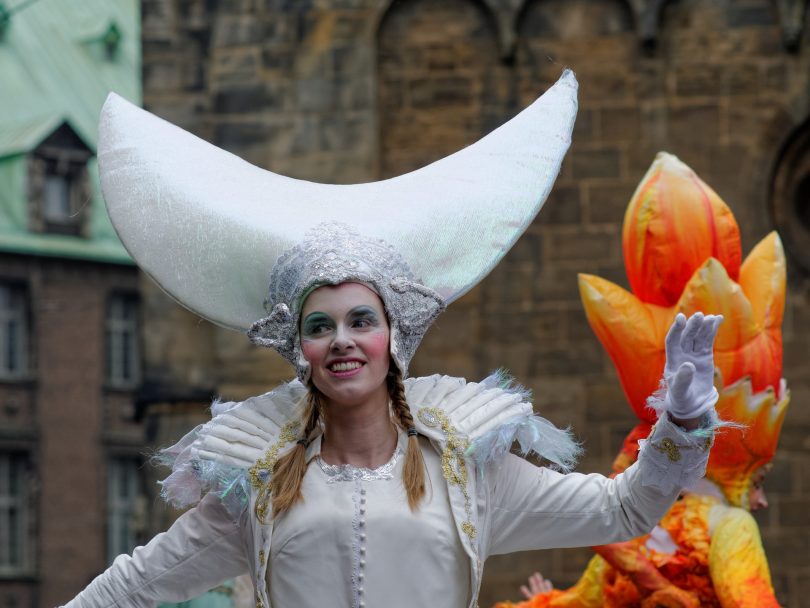

Photo via Pixabay
Life moves forward from one festivity to the other, and therefore life should be celebrated. After the Christmas season, the next celebration on the calendar is Carnival. Let’s take a look at how and where to celebrate Carnival in Barcelona in 2022.
This year carnival runs from 24 February to 2 March, which means there are seven full days of colourful festivities that will take place in every district of the city.
Table of Contents
Barcelona prides itself on its traditions and its popular festivals, so this, of course, also counts for carnival. In Barcelona there is an entire week of festivities.
Fat Thursday (or Dijous Gras) marks the start of all carnival celebrations. This day is filled with traditions, and one of them is, of course, the tradition of good food. In Barcelona they specifically eat: butifarra de huevo (sausage), tortilla (potatodish) and coca de chicharrones (also called Coca de llardons in Catalan – a thicker bread with baked bacon strips).
It is very common for schools and among friends to organise a meal together or have snacks. And after this, they go to the centre of Barcelona to see a show in the afternoon.
One of the most typical activities during the week is La Taronjada, a happening that is almost a thousand years old, which was banned in 1333, because the main objective of this event was throwing (heavy) oranges.
Nowadays, however, te event is more peaceful as oranges have been replaced with orange balloons filled with confetti to represent the previous battle that took place.
During the carnival weekend (Friday 25, Saturday 26 and Sunday 27 February) the city will be filled with a vibrant atmosphere, people will be in costume and there will be lots of fun and laughter. Activities will be organised for all different ages, and there will be floats parading through the streets of most of Barcelona’s neighbourhoods.
Related article: Best Costume Stores in Barcelona
In addition to the popular festivities we have already mentioned, most discotheques and bars will also take advantage of the carnival festival. They will decorate their interior to meet the joyful atmosphere. After all, carnival is for everyone!
During the days of carnival, the old quarter of Barcelona is the scene of many of the rúas, including the arrival of the King of Carnestoltes and the children’s parades which are organised by schools. The people in these parades are all dressed up in costumes.
Out of all of these parades, one of the most outstanding is the one held in the neighbourhood of Barceloneta, but unfortunately it was decided to postpone the Carnavalada until March this year.
After an intense and festive carnival weekend comes Wednesday 2 March, also known as Ash Wednesday, when carnival comes to an end with the burial of the sardine.
This day symbolises the death of the King and Queen of Carnestoltes, so the parade through the streets will maybe surprise you with its “mourning” atmosphere, where goodbye is being said to the main characters.
And last but not least, and if you happen to like sardines, you can’t miss this last event: the popular sardinadas that are being organised in many of the city’s neighbourhoods.
The first documentation we find of carnival in Barcelona is from the Concilio de Ciento in 1333, in which the throwing of oranges is being prohibited and the use of masks is being regularised.
This means that carnival in Barcelona has been celebrated for centuries and centuries, but in the 16th century public authorities took control of the festival and they created the events as we know them today: Fat Thursday, Carnival Friday and Ash Wednesday.
The introduction of costumes, however, came much later than you might expect, because this started happening in the 19th century and it was due to the success of satirical novels that costumes became part of the tradition. To comlete this part on the history of carnival, we must also address the fact that during Franco’s dictatorship not a single Carnival was celebrated in our city.
Only 35 minutes from Barcelona you will find one of the most spectacular carnival celebrations in Catalonia, the Sitges Carnival. This coastal town is located in the Garraf region, and it is one of the most significant locations for the gay community.
During the week of carnival, Sitges usually welcomes around 300,000 people, which means the population nearly tenfolds. It is a festival that also goes back a long time, as the first documentation mentioning carnival dates back to the 15th century.
In the days leading up to the carnival festival, but also throughout the entire week of carnival, the town organises many different activities, such as competitions and music shows with lots of colour. You can check the full programme for carnival in Sitges here.
So if you don’t want to miss what carnival in its purest form is all about, get this week off and come to Barcelona or Sitges. It will be a different carnival than at home.
Where will you celebrate carnival this year?
Sources:
Barcelona’s Mediterranean climate, with increasingly warmer and longer summers, makes air conditioning an essential feature…
Maybe you're thinking about selling a property or you've just inherited one or more real…
Do you enjoy strolling among trees and plants, away from the hustle and bustle of…
If you are planning to move to Barcelona for a few months or permanently, one…
ShBarcelona establishes itself as the leading agency within the Apialia Eixample Group, reaffirming its position…
Are you going to visit Barcelona this 2025? The vibrant Catalan capital once again becomes…